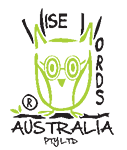-
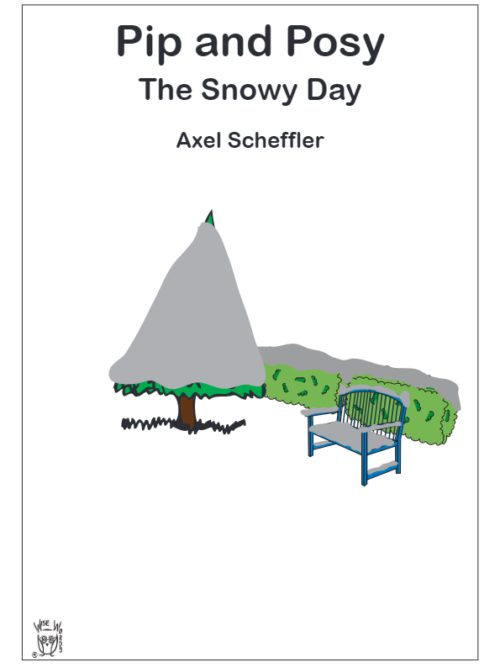 USING BOOKS TO ENHANCE A CHILD'S UNDERSTANDING AND INCREASE HIS/HER EXPRESSIVE LANGUAGE You can use a book to expand a child's • vocabulary (snow, waterproof, mittens, snowflakes, sorry, footprints) • understanding of concepts (e.g. warm, comfy, cold, kind) • ability to understand questions Wise Words Scripts - offer clinicians, teachers and parents readily available questions designed specifically for each book. A script provides a variety of questions at each level of understanding for each page of the book. A teacher or clinician working with a group of children can tailor questions to each child's language ability. This script and other available scripts have been based on Marion Blank's Model of Classroom Language. Marion Blank recognised the importance of keeping questions and statements within a child’s level of understanding. The more concrete the statement or question, the easier it will be for the child to understand. As questions become more abstract, they become harder for children to answer. The Blank Model is divided into 4 levels of questioning, moving from the concrete (easiest) at Level 1 to the abstract (most difficult) at Level 4.
USING BOOKS TO ENHANCE A CHILD'S UNDERSTANDING AND INCREASE HIS/HER EXPRESSIVE LANGUAGE You can use a book to expand a child's • vocabulary (snow, waterproof, mittens, snowflakes, sorry, footprints) • understanding of concepts (e.g. warm, comfy, cold, kind) • ability to understand questions Wise Words Scripts - offer clinicians, teachers and parents readily available questions designed specifically for each book. A script provides a variety of questions at each level of understanding for each page of the book. A teacher or clinician working with a group of children can tailor questions to each child's language ability. This script and other available scripts have been based on Marion Blank's Model of Classroom Language. Marion Blank recognised the importance of keeping questions and statements within a child’s level of understanding. The more concrete the statement or question, the easier it will be for the child to understand. As questions become more abstract, they become harder for children to answer. The Blank Model is divided into 4 levels of questioning, moving from the concrete (easiest) at Level 1 to the abstract (most difficult) at Level 4. -
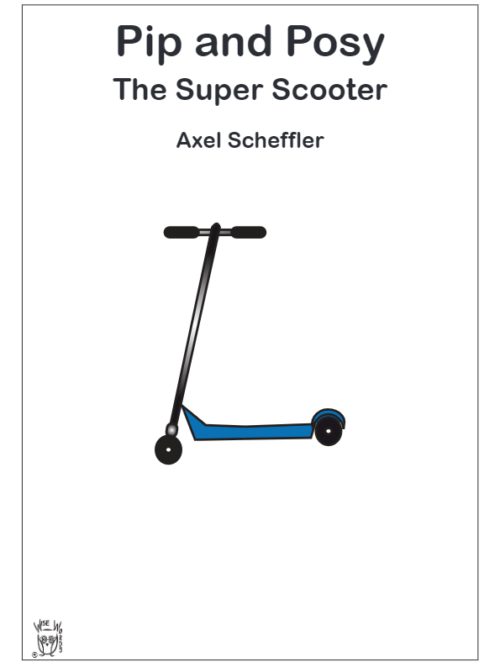 USING BOOKS TO ENHANCE A CHILD'S UNDERSTANDING AND INCREASE HIS/HER EXPRESSIVE LANGUAGE You can use a book to expand a child's • vocabulary (appeared, snatched, sore, tricks) • understanding of concepts (e.g. fast, easy, careful, soft) • ability to understand questions Wise Words Scripts - offer clinicians, teachers and parents readily available questions designed specifically for each book. A script provides a variety of questions at each level of understanding for each page of the book. A teacher or clinician working with a group of children can tailor questions to each child's language ability. This script and other available scripts have been based on Marion Blank's Model of Classroom Language. Marion Blank recognised the importance of keeping questions and statements within a child’s level of understanding. The more concrete the statement or question, the easier it will be for the child to understand. As questions become more abstract, they become harder for children to answer. The Blank Model is divided into 4 levels of questioning, moving from the concrete (easiest) at Level 1 to the abstract (most difficult) at Level 4.
USING BOOKS TO ENHANCE A CHILD'S UNDERSTANDING AND INCREASE HIS/HER EXPRESSIVE LANGUAGE You can use a book to expand a child's • vocabulary (appeared, snatched, sore, tricks) • understanding of concepts (e.g. fast, easy, careful, soft) • ability to understand questions Wise Words Scripts - offer clinicians, teachers and parents readily available questions designed specifically for each book. A script provides a variety of questions at each level of understanding for each page of the book. A teacher or clinician working with a group of children can tailor questions to each child's language ability. This script and other available scripts have been based on Marion Blank's Model of Classroom Language. Marion Blank recognised the importance of keeping questions and statements within a child’s level of understanding. The more concrete the statement or question, the easier it will be for the child to understand. As questions become more abstract, they become harder for children to answer. The Blank Model is divided into 4 levels of questioning, moving from the concrete (easiest) at Level 1 to the abstract (most difficult) at Level 4. -
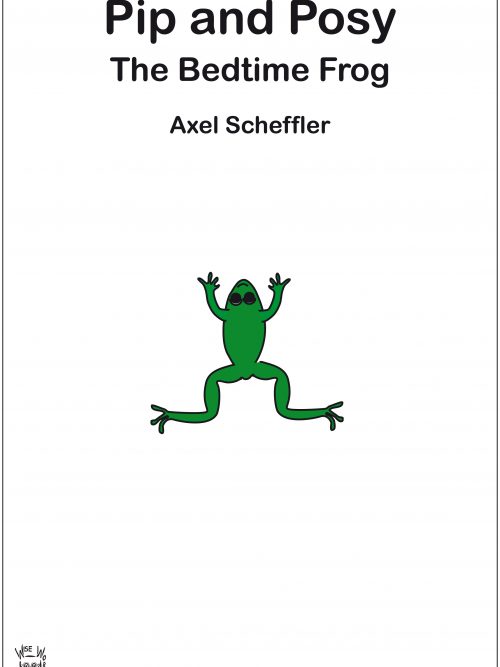 USING BOOKS TO ENHANCE A CHILD'S UNDERSTANDING AND INCREASE HIS/HER EXPRESSIVE LANGUAGE You can use a book to expand a child's • Vocabulary (stool, kennel, basket, sty, reaching, searching) • Understanding of concepts (e.g. big - little, wet - dry, nearly, scary, funny) • Ability to understand questions Wise Words Scripts - offer clinicians, teachers and parents readily available questions designed specifically for each book. A script provides a variety of questions at each level of understanding for each page of the book. A teacher or clinician working with a group of children can tailor questions to each child's language ability. This script and other available scripts have been based on Marion Blank's Model of Classroom Language. Marion Blank recognised the importance of keeping questions and statements within a child’s level of understanding. The more concrete the statement or question, the easier it will be for the child to understand. As questions become more abstract, they become harder for children to answer. The Blank Model is divided into 4 levels of questioning, moving from the concrete (easiest) at Level 1 to the abstract (most difficult) at Level 4.
USING BOOKS TO ENHANCE A CHILD'S UNDERSTANDING AND INCREASE HIS/HER EXPRESSIVE LANGUAGE You can use a book to expand a child's • Vocabulary (stool, kennel, basket, sty, reaching, searching) • Understanding of concepts (e.g. big - little, wet - dry, nearly, scary, funny) • Ability to understand questions Wise Words Scripts - offer clinicians, teachers and parents readily available questions designed specifically for each book. A script provides a variety of questions at each level of understanding for each page of the book. A teacher or clinician working with a group of children can tailor questions to each child's language ability. This script and other available scripts have been based on Marion Blank's Model of Classroom Language. Marion Blank recognised the importance of keeping questions and statements within a child’s level of understanding. The more concrete the statement or question, the easier it will be for the child to understand. As questions become more abstract, they become harder for children to answer. The Blank Model is divided into 4 levels of questioning, moving from the concrete (easiest) at Level 1 to the abstract (most difficult) at Level 4. -
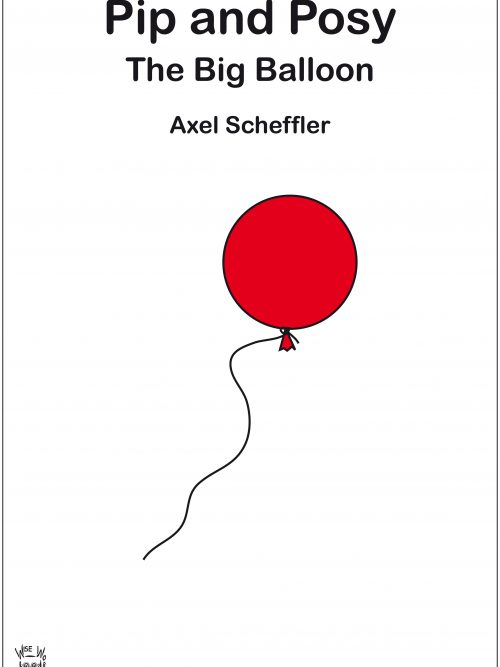 USING BOOKS TO ENHANCE A CHILD'S UNDERSTANDING AND INCREASE HIS/HER EXPRESSIVE LANGUAGE You can use a book to expand a child's • Vocabulary (stool, kennel, basket, sty, reaching, searching) • Understanding of concepts (e.g. big - little, wet - dry, nearly, scary, funny) • Ability to understand questions Wise Words Scripts - offer clinicians, teachers and parents readily available questions designed specifically for each book. A script provides a variety of questions at each level of understanding for each page of the book. A teacher or clinician working with a group of children can tailor questions to each child's language ability. This script and other available scripts have been based on Marion Blank's Model of Classroom Language. Marion Blank recognised the importance of keeping questions and statements within a child’s level of understanding. The more concrete the statement or question, the easier it will be for the child to understand. As questions become more abstract, they become harder for children to answer. The Blank Model is divided into 4 levels of questioning, moving from the concrete (easiest) at Level 1 to the abstract (most difficult) at Level 4.
USING BOOKS TO ENHANCE A CHILD'S UNDERSTANDING AND INCREASE HIS/HER EXPRESSIVE LANGUAGE You can use a book to expand a child's • Vocabulary (stool, kennel, basket, sty, reaching, searching) • Understanding of concepts (e.g. big - little, wet - dry, nearly, scary, funny) • Ability to understand questions Wise Words Scripts - offer clinicians, teachers and parents readily available questions designed specifically for each book. A script provides a variety of questions at each level of understanding for each page of the book. A teacher or clinician working with a group of children can tailor questions to each child's language ability. This script and other available scripts have been based on Marion Blank's Model of Classroom Language. Marion Blank recognised the importance of keeping questions and statements within a child’s level of understanding. The more concrete the statement or question, the easier it will be for the child to understand. As questions become more abstract, they become harder for children to answer. The Blank Model is divided into 4 levels of questioning, moving from the concrete (easiest) at Level 1 to the abstract (most difficult) at Level 4. -
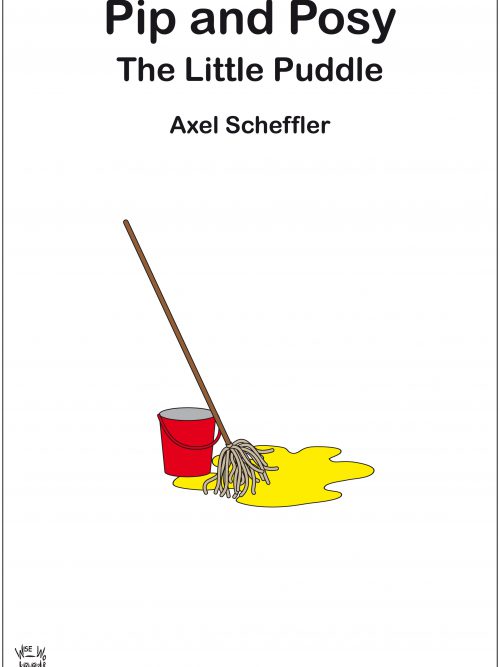 USING BOOKS TO ENHANCE A CHILD'S UNDERSTANDING AND INCREASE HIS/HER EXPRESSIVE LANGUAGE You can use a book to expand a child's • Vocabulary (magnificent, sail, squelchy, sniffing, pretending) • Understanding of concepts (e.g. cold, round, white, cosy, kind, sometimes) • Ability to understand questions Wise Words Scripts - offer clinicians, teachers and parents readily available questions designed specifically for each book. A script provides a variety of questions at each level of understanding for each page of the book. A teacher or clinician working with a group of children can tailor questions to each child's language ability. This script and other available scripts have been based on Marion Blank's Model of Classroom Language. Marion Blank recognised the importance of keeping questions and statements within a child’s level of understanding. The more concrete the statement or question, the easier it will be for the child to understand. As questions become more abstract, they become harder for children to answer. The Blank Model is divided into 4 levels of questioning, moving from the concrete (easiest) at Level 1 to the abstract (most difficult) at Level 4.
USING BOOKS TO ENHANCE A CHILD'S UNDERSTANDING AND INCREASE HIS/HER EXPRESSIVE LANGUAGE You can use a book to expand a child's • Vocabulary (magnificent, sail, squelchy, sniffing, pretending) • Understanding of concepts (e.g. cold, round, white, cosy, kind, sometimes) • Ability to understand questions Wise Words Scripts - offer clinicians, teachers and parents readily available questions designed specifically for each book. A script provides a variety of questions at each level of understanding for each page of the book. A teacher or clinician working with a group of children can tailor questions to each child's language ability. This script and other available scripts have been based on Marion Blank's Model of Classroom Language. Marion Blank recognised the importance of keeping questions and statements within a child’s level of understanding. The more concrete the statement or question, the easier it will be for the child to understand. As questions become more abstract, they become harder for children to answer. The Blank Model is divided into 4 levels of questioning, moving from the concrete (easiest) at Level 1 to the abstract (most difficult) at Level 4. -
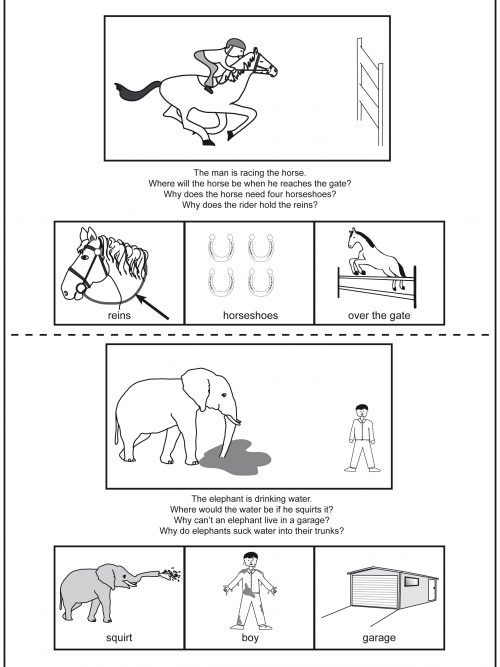
Level 4
Predicting changes in position “What will you see if ...?” “Where will the ... be if ...?” Explaining the means to a goal “Why did the ...?” “Why should he ...?” Explaining obstacles to an action “Why can’t the helicopter ...?” “Why won’t the ...?” This program can be used with both readers and non-readers alike. If a child can read, it is suggested that the ‘without words’ version is used to avoid reliance on the written prompt. Parents or carers have access to the written label in order to guide their child with each task. It is important for the parent, teacher or clinician to lead the child towards the salient features of the presented information. Point to a picture, parts of a picture or break down the statements into simple content in order to give the child an opportunity to understand. If your child appears to be struggling with the questions, it is essential to talk more but at a simple level of understanding so that the child reaches the appropriate response by himself. Rephrasing the information will ensure that he is able to draw on past experiences or make inferences. This should help him to understand the question and then offer a solution. -
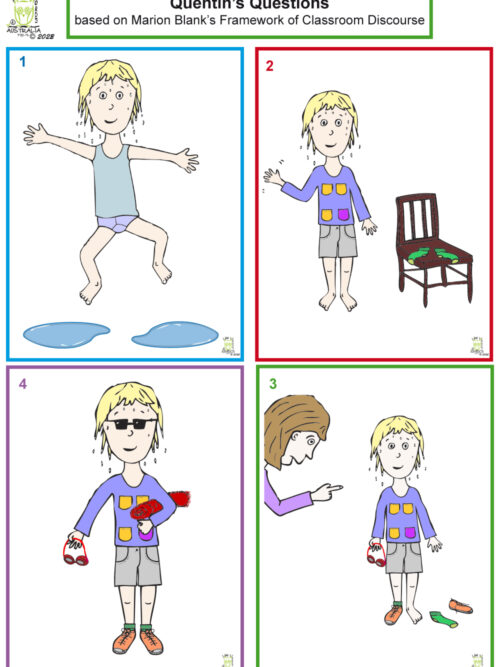 This product includes four picture cards depicting a young boy. Each illustration has accompanying questions at Levels 1, 2, 3 and 4 and are based on Marion Blank’s Model of Classroom Language. (Blank, Rose & Berlin 1978). The cards will provide teachers and clinicians with a useful tool where questions and statements can be quickly tailored to the needs of every child despite differing ages or abilities.
This product includes four picture cards depicting a young boy. Each illustration has accompanying questions at Levels 1, 2, 3 and 4 and are based on Marion Blank’s Model of Classroom Language. (Blank, Rose & Berlin 1978). The cards will provide teachers and clinicians with a useful tool where questions and statements can be quickly tailored to the needs of every child despite differing ages or abilities. -
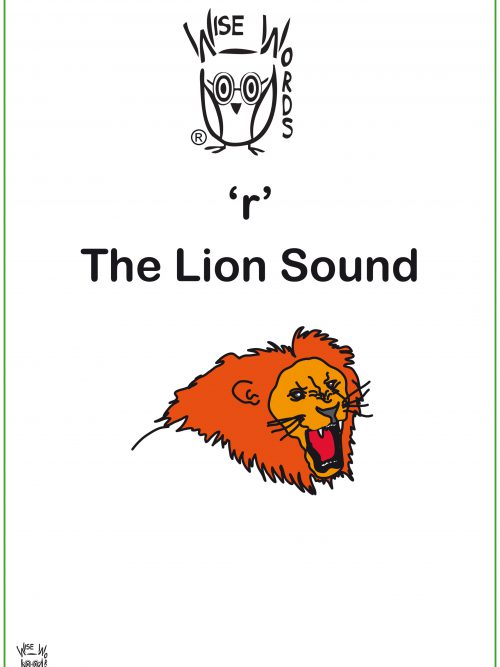 Wise Words Articulation Programs - support clinicians, teachers and parents to establish 'new' (correct) sounds into their child's speech. Each program supplies detailed instructions for every task and game. The instructions have been written in a clear manner for a non-professional to follow. Numerous games are provided. These games have been designed to be fun and interactive and will ensure that the child remains engaged and compliant. Playing the games will help the child to generalise the ‘new’ sound into their everyday speech..
Wise Words Articulation Programs - support clinicians, teachers and parents to establish 'new' (correct) sounds into their child's speech. Each program supplies detailed instructions for every task and game. The instructions have been written in a clear manner for a non-professional to follow. Numerous games are provided. These games have been designed to be fun and interactive and will ensure that the child remains engaged and compliant. Playing the games will help the child to generalise the ‘new’ sound into their everyday speech.. -
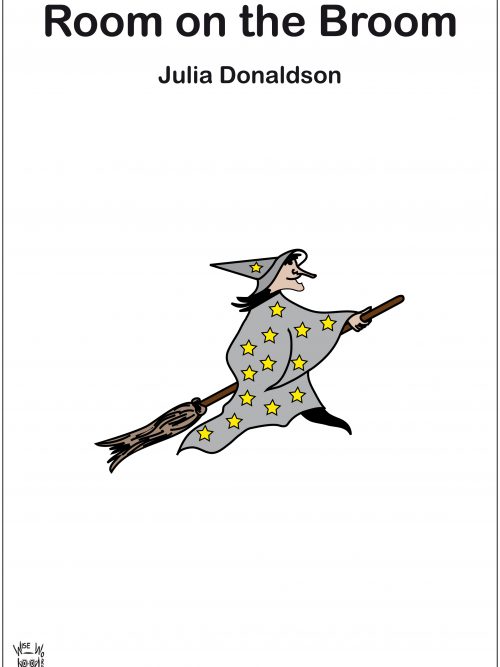 USING BOOKS TO ENHANCE A CHILD'S UNDERSTANDING AND INCREASE HIS/HER EXPRESSIVE LANGUAGE You can use a book to expand a child's • vocabulary (plait, beast, fluttered, cloak, cauldron, bog) • understanding of concepts (storm, tall, scary, clean, politely) • ability to understand questions Wise Words Scripts - offer clinicians, teachers and parents readily available questions designed specifically for each book. A script provides a variety of questions at each level of understanding for each page of the book. A teacher or clinician working with a group of children can tailor questions to each child's language ability. This script and other available scripts have been based on Marion Blank's Model of Classroom Language. Marion Blank recognised the importance of keeping questions and statements within a child’s level of understanding. The more concrete the statement or question, the easier it will be for the child to understand. As questions become more abstract, they become harder for children to answer. The Blank Model is divided into 4 levels of questioning, moving from the concrete (easiest) at Level 1 to the abstract (most difficult) at Level 4.
USING BOOKS TO ENHANCE A CHILD'S UNDERSTANDING AND INCREASE HIS/HER EXPRESSIVE LANGUAGE You can use a book to expand a child's • vocabulary (plait, beast, fluttered, cloak, cauldron, bog) • understanding of concepts (storm, tall, scary, clean, politely) • ability to understand questions Wise Words Scripts - offer clinicians, teachers and parents readily available questions designed specifically for each book. A script provides a variety of questions at each level of understanding for each page of the book. A teacher or clinician working with a group of children can tailor questions to each child's language ability. This script and other available scripts have been based on Marion Blank's Model of Classroom Language. Marion Blank recognised the importance of keeping questions and statements within a child’s level of understanding. The more concrete the statement or question, the easier it will be for the child to understand. As questions become more abstract, they become harder for children to answer. The Blank Model is divided into 4 levels of questioning, moving from the concrete (easiest) at Level 1 to the abstract (most difficult) at Level 4. -
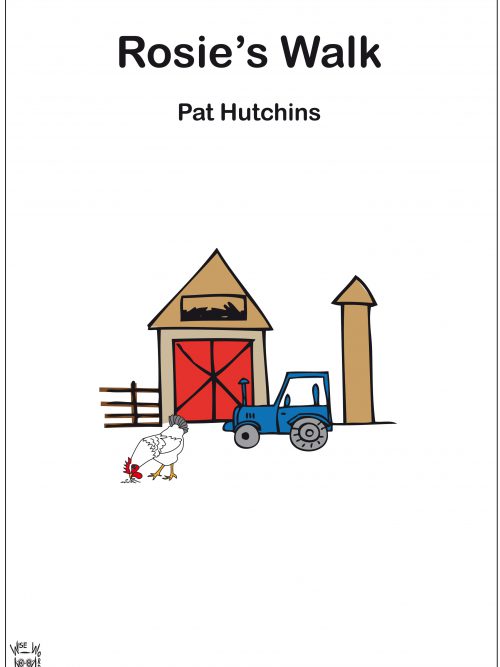 USING BOOKS TO ENHANCE A CHILD'S UNDERSTANDING AND INCREASE HIS/HER EXPRESSIVE LANGUAGE You can use a book to expand a child's • vocabulary (pond, fox, goat, windmill, jumped, stinging) • understanding of concepts (e.g. wet, heavy, light, white, many, through) • ability to understand questions Wise Words Scripts - offer clinicians, teachers and parents readily available questions designed specifically for each book. A script provides a variety of questions at each level of understanding for each page of the book. A teacher or clinician working with a group of children can tailor questions to each child's language ability. This script and other available scripts have been based on Marion Blank's Model of Classroom Language. Marion Blank recognised the importance of keeping questions and statements within a child’s level of understanding. The more concrete the statement or question, the easier it will be for the child to understand. As questions become more abstract, they become harder for children to answer. The Blank Model is divided into 4 levels of questioning, moving from the concrete (easiest) at Level 1 to the abstract (most difficult) at Level 4.
USING BOOKS TO ENHANCE A CHILD'S UNDERSTANDING AND INCREASE HIS/HER EXPRESSIVE LANGUAGE You can use a book to expand a child's • vocabulary (pond, fox, goat, windmill, jumped, stinging) • understanding of concepts (e.g. wet, heavy, light, white, many, through) • ability to understand questions Wise Words Scripts - offer clinicians, teachers and parents readily available questions designed specifically for each book. A script provides a variety of questions at each level of understanding for each page of the book. A teacher or clinician working with a group of children can tailor questions to each child's language ability. This script and other available scripts have been based on Marion Blank's Model of Classroom Language. Marion Blank recognised the importance of keeping questions and statements within a child’s level of understanding. The more concrete the statement or question, the easier it will be for the child to understand. As questions become more abstract, they become harder for children to answer. The Blank Model is divided into 4 levels of questioning, moving from the concrete (easiest) at Level 1 to the abstract (most difficult) at Level 4. -
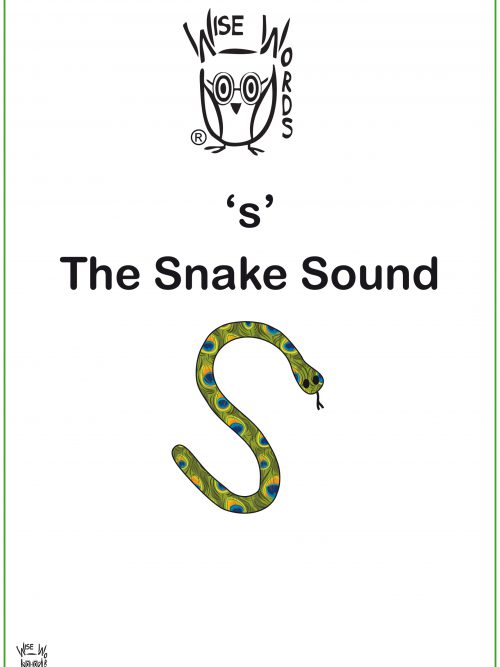 Wise Words Articulation Programs - support clinicians, teachers and parents to establish 'new' (correct) sounds into their child's speech. Each program supplies detailed instructions for every task and game. The instructions have been written in a clear manner for a non-professional to follow. Numerous games are provided. These games have been designed to be fun and interactive and will ensure that the child remains engaged and compliant. Playing the games will help the child to generalise the ‘new’ sound into their everyday speech.
Wise Words Articulation Programs - support clinicians, teachers and parents to establish 'new' (correct) sounds into their child's speech. Each program supplies detailed instructions for every task and game. The instructions have been written in a clear manner for a non-professional to follow. Numerous games are provided. These games have been designed to be fun and interactive and will ensure that the child remains engaged and compliant. Playing the games will help the child to generalise the ‘new’ sound into their everyday speech. -
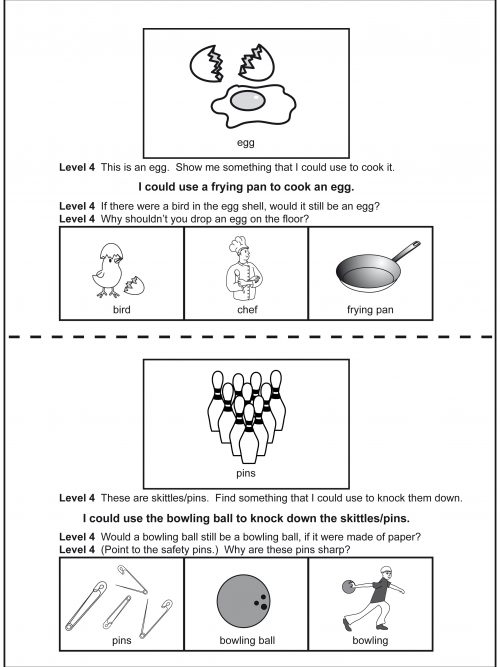
Level 4
Selecting the Means to a Goal Level 4 “What should I use to ...?” “What could I use to ...?” “What might he use when ...?” Explaining the Means to a Goal Level 4 “Why should she use...?” “What made him use ..?” “Why would she use ...?” Explaining obstacles to an action & Formulating a Solution Level 4 “Why can’t he use ... to ...?” “Why shouldn’t we use ...?” “What might happen if he ...?” “What could you use if ...?” “The boy is ... What could he do to ...?” “What would you do if ...?” Contents/product description - This program can be used with both readers and non-readers alike. Questions are used to guide your child through the thinking process so that he/she will reach the appropriate conclusion without being provided with the answer. It is important for the parent, teacher or clinician to lead the child towards the salient features of the presented problem. It may become necessary for the adult to break down the problem scenario into smaller parts to give the child the opportunity to understand. It is then essential to talk more, at a simple level, in language that the child understands. Rephrasing the information will ensure that the child is able to make inferences, understand the problem and then offer a solution. The large picture sets the scene for the child but does not provide answers. Possible solutions (tools) to each problem are located in the three smaller squares below. Example of a task/activity Point to and name the large picture of the loaf of bread. This picture is the feature which the child will need to consider. Now name each of the smaller pictures. The deliberate foil (a slice of bread) may misdirect the child if he/she does not fully understand the question. This topic is concerned with slicing bread. The following solutions are offered: • a knife - the correct answer - something used for slicing • slice of bread - the foil • a spoon - something that is used for eating but not for slicing bread. -
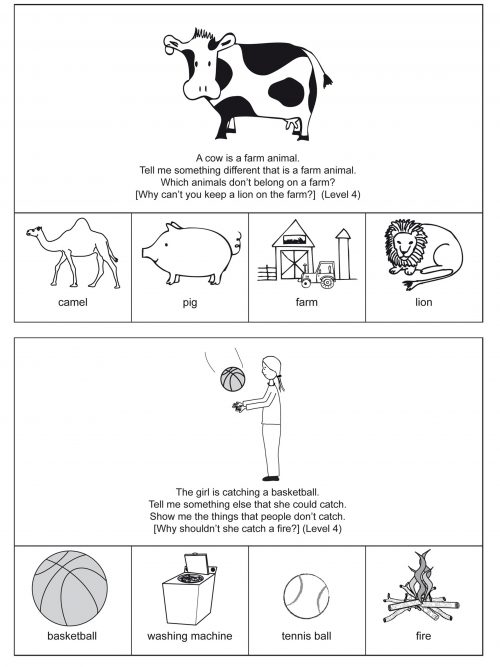
Level 3 (& Level 4)
Selecting an Object or Set of Objects by Exclusion Level 3 “Tell me something else that ...” “Tell me something different that ..." "Show me the things that aren’t ...” “Point to the things that don’t ...” “Find the things that the boy can’t ...” Reasoning Level 4 “Why is a ... made of ...?" "What should he do if ...?" "Why wouldn't ...?" "What could you use to ...?" "What could you ... if ...?" This program targets Level 3 questions and statements. At this level of understanding, your child will need to look beyond the material in front of him/her. He/she will be required to evaluate and reorder the information. A typical skill in this category is the ability to exclude material. Your child will need to follow directions which may use the words ‘not, don’t, can’t, something else, other than’. The activities in this program have been designed specifically to help your child recognise alternatives. A number of Level 4 questions have been included in this program. These tasks will prove useful for those children who are working towards a more abstract type of question. Questions at this level include Why should ...? Why shouldn’t ...? Why can ...? Why can’t ...? What could ...? How can we tell ...? At this level of understanding, your child will need to look beyond the material in front of him/her and will then be required to evaluate and reorder the information. A typical skill in this category is the ability to exclude material. Your child will need to follow directions which may include the words ‘not, don’t, can’t, something else, other than’. The activities in this program have been designed specifically to help your child recognise alternatives. Example of a Level 3 Activity: 1. “A cow is a farm animal. “Tell me something different that is a farm animal.” Your child is given the following possible answers: A camel - An animal but not a farm animal. A pig - The correct answer. This is an alternative farm animal. A farm - The place where farm animals are found. A lion - An animal but not a farm animal. 2. “Which animals don’t belong on the farm?” - “Camel, lion” Example of a Level 4 Activity 1.“Mum fills the kettle with water. How can we tell that the kettle is boiling?" 2. “Frogs can jump. Why can’t snails jump? -
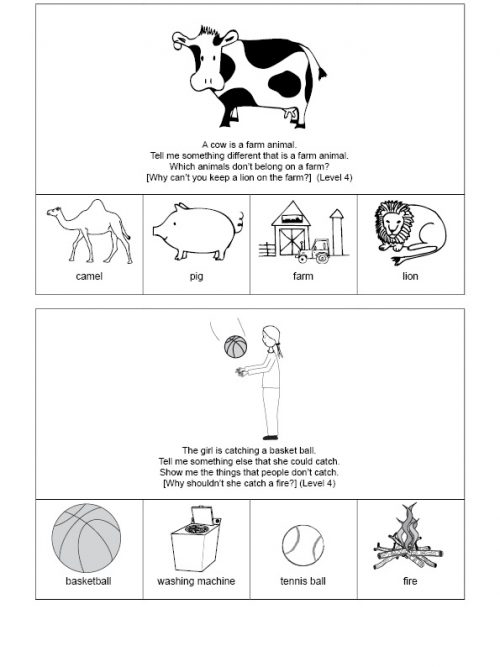
Level 3 (& Level 4)
Selecting an Object or Set of Objects by Exclusion Level 3 “Tell me something else that ...” “Tell me something different that ..." "Show me the things that aren’t ...” “Point to the things that don’t ...” “Find the things that the boy can’t ...” Reasoning & Problem Solving Level 4 “Why is a ... made of ...?" "What should he do if ...?" "Why wouldn't ...?" "What could you use to ...?" "What could you ... if ...?" This program targets Level 3 questions and statements. At this level of understanding, your child will need to look beyond the material in front of him. He will be required to evaluate and reorder the information. A typical skill in this category is the ability to exclude material. Your child will need to follow directions which may use the words ‘not, don’t, can’t, something else, other than’. The activities in this program have been designed specifically to help your child recognise alternatives. A number of Level 4 questions have been included in this program. These tasks will prove useful for those children who are working towards a more abstract type of question. Questions at this level include Why should ...? Why shouldn’t ...? Why can ...? Why can’t ...? What could ...? How can we tell ...? At this level of understanding, your child will need to look beyond the material in front of him/her and will then be required to evaluate and reorder the information. A typical skill in this category is the ability to exclude material. Your child will need to follow directions which may include the words ‘not, don’t, can’t, something else, other than’. The activities in this program have been designed specifically to help your child recognise alternatives. Example of a Level 3 Activity 1. “A cow is a farm animal. “Tell me something different that is a farm animal.” Your child is given the following possible answers: A camel - An animal but not a farm animal. A pig - The correct answer. This is an alternative farm animal. A farm - The place where farm animals are found. A lion - An animal but not a farm animal. 2. “Which animals don’t belong on the farm?” - “Camel, lion” Example of a Level 4 Activity 1.“Mum fills the kettle with water. How can we tell that the kettle is boiling?" 2. “Frogs can jump. Why can’t snails jump? -
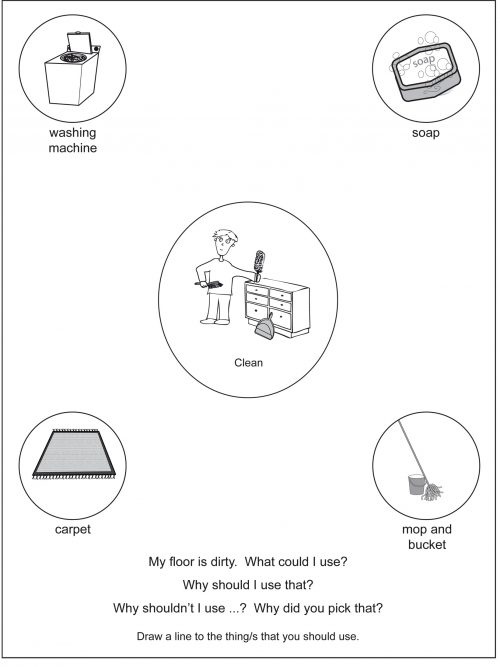
Level 4
Selecting the Means to a Goal Level 4 “What should I use to ...?” “What could I do to ...?” “What could he wear if ...?” Explaining the Means to a Goal Level 4 “Why should she use...?” “Why shouldn’t she use ..?” “Why did you pick that one?” The activities presented in this Level 4 program reflect more complex verbal problems. These activities will require your child to reason about things that may, might, could or would happen. Your will need to go beyond what can be immediately seen or perceived. He/she will need to reflect on previously gained information and use this information to solve the problem. The large circle in the middle of the page contains the “problem” which your child will need to solve. This picture will set the scene for your child but it will not give your child the answer to the question. Possible solutions to each problem are located in the four smaller circles which are placed in each corner of the page. Some solutions have been chosen in order to deliberately challenge your child. For your child to offer the correct solution they will have had to completely understand the statement and understand the question. Example of a problem: This problem is related to cleaning the floor.The following solutions are offered: A washing machine - this is something used for cleaning clothes. Soap - again something for cleaning. A carpet - something that is found on the floor. A mop and bucket - the correct answer for cleaning the floor. -
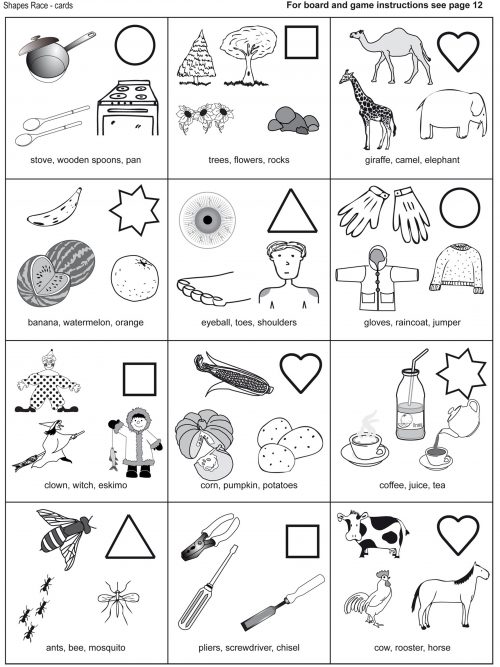
Level 2
Naming a semantic class Level 2 “A watermelon, a banana and an orange are all ...?” “What group do toes, eyeballs and shoulders belong in?” “I went shopping for new clothes. What did I buy?” Sorting according to a semantic class Level 2 “Find all the vegetables.” “Find something that is an insect.” “Show me all the farm animals.” Citing an example within a category Level 2 “Name something that is a drink.” “Tell me something that is a vegetable.” “Show me something that belongs in the transport group.” “I went to the zoo. Tell me something that I saw at the zoo.” Contents/product description - This program targets Blank’s Level 2 questions and statements. Playing the games provided in this program will help your child to understand that objects can be grouped into categories and that categories have labels (fruit, vegetables, clothes, tools, zoo animals). Playing a number of different games all targeting the same language goal will further stablise these concepts whilst ensuring that your child is engaged. Research indicates that we store and retrieve words more easily if they have been organised into ‘collections’. Working through these activities will help to increase your child’s vocabulary and improve his/her word finding skills. A child may ‘know’ a word and he may point to the appropriate object when it is named but he may not be able to retrieve the word at all or be able to retrieve the word in a timely manner. Playing the games in this program will be enjoyable for your child and should ensure that he/she repeats the tasks numerous times which will help him/her fully understand the concept. -
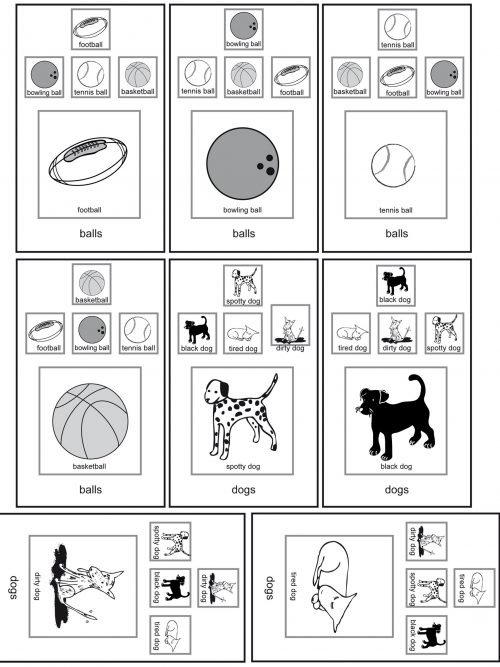
Level 2
Naming and grouping an object within a category “Find something that is a food." "Hamburger - which group does this belong in?” “Is this in the furniture group?” “Which group are you collecting?” “What belongs in your group?” Attending to two characteristics “Find something that gives milk and eats grass.” “Find something that is an animal and has a long neck.” “Find the things that grow and we can eat.” This program provides opportunities to teach the concept of semantic groups/grouping of objects. - Children learn new words more easily if they fully understand the meaning of a word. Therefore, it is important for the child to understand the semantic features and how a word can be categorised. Initially he is required to group non-identical but almost the same objects. The semantic features and similarities of each object are discussed and sorted using the ‘Group Board’. This activity gives the child a number of links to the non-identical objects (cars) or group name (e.g. fruit, transport). Discussing and comparing the semantic features of objects provides a ‘mapping’ experience to ensure that the word is learnt more successfully. This program can also be used to target and identify similarities or differences while providing the child with additional information to use inductive reasoning. Research indicates that we store and retrieve words more easily if they have been organised into ‘collections’. Two important ways that we can organise words are by ... • Function - what we do with something (eat cake), what we use it for (cut with - scissors) or what it does (a bird flies). • Semantic Class - A ‘word family’ includes groups such as food (cake, eggs, bread, cheese), wild animals (zebra, giraffe, lion, monkey), furniture (chair, bed, table, shelves). This program targets the classification of objects into Semantic Classes whilst providing the child with multiple links which they can use to retrieve the words at a later time. Initially the child is presented with objects which are similar (all balls) but not identical (e.g. football, tennis ball, bowling ball, basketball). Once a child is able to group non-identical objects into groups, the Semantic Class cards and boards are presented (e.g. food, furniture, clothes, farm animals). Contents - 34 pages including instructions. -
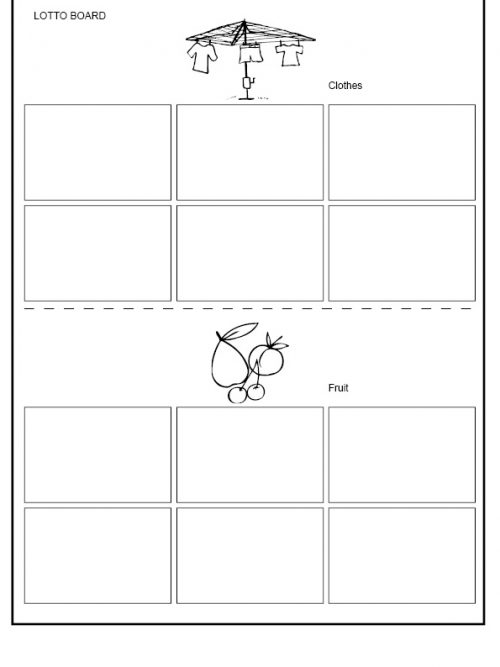
Level 2
Citing and grouping an object within a category Level 2 “Find something that is a food." "Hamburger - which group does this belong in?" "Is it the furniture group?” “Which group are you collecting?” “What belongs in your group?” Attending to two characteristics Level 2 “Find something that is round and is a food." "Noodles, cheese, bread - which group do these belong in? “Find something that is an animal and has a long neck.” Level 2 questions require your child to direct their attention on the material directly in front of them, but at the same time he/she will need to focus more selectively on this material. Research indicates that we store and retrieve words more easily if they have been organised into 'collections'. Two important ways that we can organise words are according to: Function - what we do with something (eat cake), what we use it for (cut with scissors) or what it does (a bird flies). Semantic Class - A 'word family' which includes groups such as food (cake, eggs, bread, cheese), wild animals (zebra, giraffe, lion, monkey), furniture (chair, bed, table, shelves). The activities in this program will help your child to sort materials into semantic groups and use the collective group name for objects. For example: clothes - jumper, jeans, shirt, socks, dress, singlet fruit - apple, banana, orange, pineapple, grapes, watermelon The lotto boards, individual object cards and group cards can be used in a number of different activities and games. Varying the task will ensure that your child remains engaged and focused on the activities, whilst repeating the task several times. -
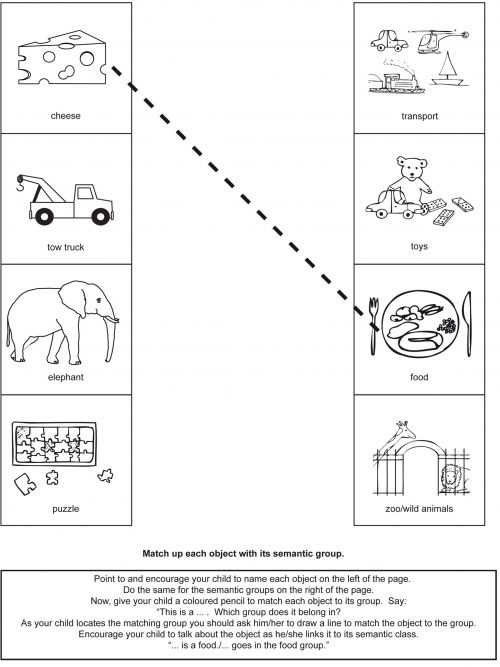
Level 2
Naming and grouping an object within a category “Find something that is a food." "Hamburger - which group does this belong in?” “Is it the furniture group?” “Which group are you collecting?” “What belongs in your group?” Citing an Example within a Category “Name something that is a food." "Tell me something that belongs in the kitchen.” “Find something that is a farm animal.” “Point to something that belongs in the sky.” Contents/product description - Research indicates that we store and retrieve words more easily if the words are arranged into ‘collections’. Two important ways that we can sort and group words are by ...- Function - what we do with something (eat cake), what we use it for (cut with scissors) or what it does (a bird flies).
- Semantic Class - A ‘word family’ which includes groups such as food (cake, eggs, bread, cheese), wild animals (zebra, giraffe, lion, monkey), furniture (chair, bed, table, shelves).
-
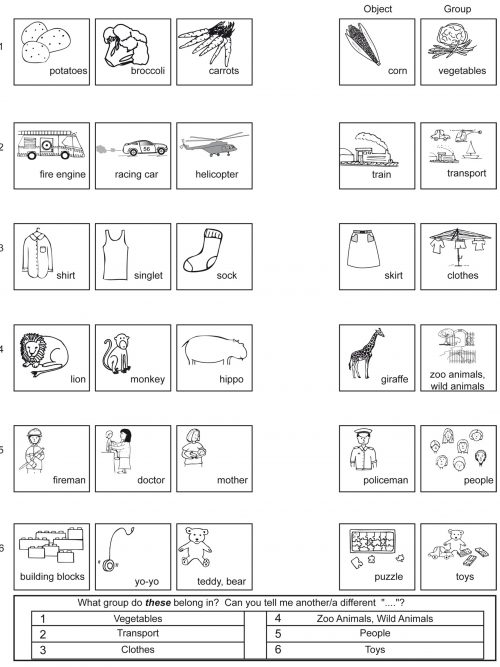
Level 2
Citing and grouping an object within a category Level 2 “Find something that is a food." "Noodles, cheese, bread - which group do these belong in?" All Wise Words Language programs are underpinned by Marion Blank’s Model of Classroom Language. This program will target Level 2 type questions and statements. Research indicates that we store and retrieve words more easily if they have been organised into “collections”. Two important ways that we can organise words are according to: Function - (what we do with something (eat cake), what we use it for (cut with scissors) or what it does (a bird flies). Semantic Class - A “word family” which includes groups such as food (cake, eggs, bread, cheese), wild animals (zebra, giraffe, lion, monkey), furniture (chair, bed, table, shelves). These worksheets have been designed to help your child recognise Semantic Categories. Your child will learn to group objects into categories and they will learn to use category labels. Example of an activity: Point to the first row of objects on the page. Encourage or help your child name each object. Say: “What group do these belong in?” “vegetable” Now ask your child to find the picture of the vegetable group and place it next to the row of vegetables. Next ask your child: “Can you tell me another vegetable?” or “Can you find me a different vegetable?” “corn” If your child cannot recall an alternative vegetable to the three already depicted, you may wish to offer him/her a choice of three other objects .... "Is a giraffe a vegetable?" "Is a train a vegetable?" "Is corn a vegetable? Yes, corn is a vegetable and corn belongs in the vegetable group."
